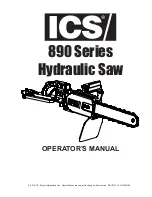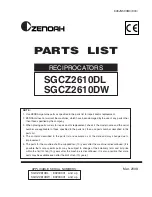
English
6
Important Safety Instructions for All
Battery Chargers
WARNING: Read all safety warnings,
instructions, and cautionary markings for the
battery pack, charger and product. Failure to
follow the warnings and instructions may result
in electric shock, fire and/or serious injury.
•
DO NOT attempt to charge the battery pack with
any chargers other than a
D
e
WALT
charger.
D
e
WALT
chargers and battery packs are specifically designed to
work together.
•
These chargers are not intended for any uses other
than charging
D
e
WALT
rechargeable batteries.
Any other uses may result in risk of fire, electric shock
or electrocution.
•
Do not expose the charger to rain or snow.
•
Pull by the plug rather than the cord when
disconnecting the charger.
This will reduce the risk of
damage to the electric plug and cord.
•
Make sure that the cord is located so that it will not
be stepped on, tripped over or otherwise subjected
to damage or stress.
•
Do not use an extension cord unless it is absolutely
necessary.
Use of improper extension cord could result in
risk of fire, electric shock or electrocution.
•
When operating a charger outdoors, always provide
a dry location and use an extension cord suitable
for outdoor use.
Use of a cord suitable for outdoor use
reduces the risk of electric shock.
120V Max* (two 60V Max* batteries) product, it will operate
as a 60V Max* battery.
shipping Mode:
When
the cap is attached to
the FLEXVOLT™ battery,
the battery is in Shipping
Mode. Strings of cells are
electrically disconnected within the pack resulting in three
batteries with a lower Watt hour (Wh) rating as compared
to one battery with a higher Watt hour rating. This increased
quantity of three batteries with the lower Watt hour rating
can exempt the pack from certain shipping regulations that
are imposed upon the higher Watt hour batteries.
The battery label indicates two Watt hour ratings (see
example). Depending on how the battery is shipped, the
appropriate Watt hour rating must be used to determine
the applicable shipping requirements. If utilizing the
shipping cap, the pack will be considered 3 batteries at
the Watt hour rating indicated for “Shipping”. If shipping
without the cap or in a tool, the pack will be considered one
battery at the Watt hour rating indicated next to “Use”.
USE: 120 Wh Shipping: 3 x 40 Wh
Example of Use and Shipping Label Marking
For example, Shipping Wh rating might indicate 3 x 40 Wh,
meaning 3 batteries of 40 Watt hours each. The Use Wh
rating might indicate 120 Wh (1 battery implied).
•
An extension cord must have adequate wire size
(AWG or American Wire Gauge) for safety.
The
smaller the gauge number of the wire, the greater the
capacity of the cable, that is, 16 gauge has more capacity
than 18 gauge. An undersized cord will cause a drop in
line voltage resulting in loss of power and overheating.
When using more than one extension to make up the
total length, be sure each individual extension contains at
least the minimum wire size. The following table shows
the correct size to use depending on cord length and
nameplate ampere rating. If in doubt, use the next heavier
gauge. The lower the gauge number, the heavier the cord.
Minimum gauge for Cord sets
Volts
Total length of Cord in Feet
(meters)
120V
25 (7.6)
50 (15.2) 100 (30.5) 150 (45.7)
240V
50 (15.2) 100 (30.5) 200 (61.0) 300 (91.4)
Ampere Rating
American Wire gauge
More
Than
not
More
Than
0
6
18
16
16
14
6
10
18
16
14
12
10
12
16
16
14
12
12
16
14
12
Not Recommended
•
Do not place any object on top of the charger or
place the charger on a soft surface that might block
the ventilation slots and result in excessive internal
heat.
Place the charger in a position away from any heat
source. The charger is ventilated through slots in the top
and the bottom of the housing.
•
Do not operate the charger with a damaged cord
or plug
–have them replaced immediately.
•
Do not operate the charger if it has received a sharp
blow, been dropped or otherwise damaged in any
way.
Take it to an authorized service center.
•
Do not disassemble the charger; take it to an
authorized service center when service or repair
is required.
Incorrect reassembly may result in a risk of
electric shock, electrocution or fire.
•
Disconnect the charger from the outlet before
attempting any cleaning. This will reduce the risk of
electric shock.
Removing the battery pack will not reduce
this risk.
•
NEVER
attempt to connect 2 chargers together.
•
The charger is designed to operate on standard
120V household electrical power. Do not attempt to
use it on any other voltage.
This does not apply to the
vehicular charger.
WARNING:
Shock hazard. Do not allow any liquid to
get inside the charger. Electric shock may result.
WARNING:
Burn hazard. Do not submerge the
battery pack in any liquid or allow any liquid to
enter the battery pack. Never attempt to open the
battery pack for any reason. If the plastic housing of
the battery pack breaks or cracks, return to a service
center for recycling.









































